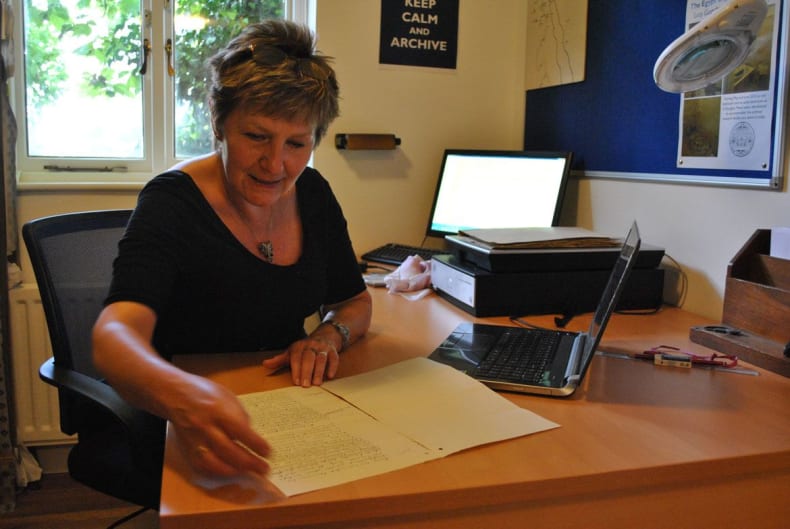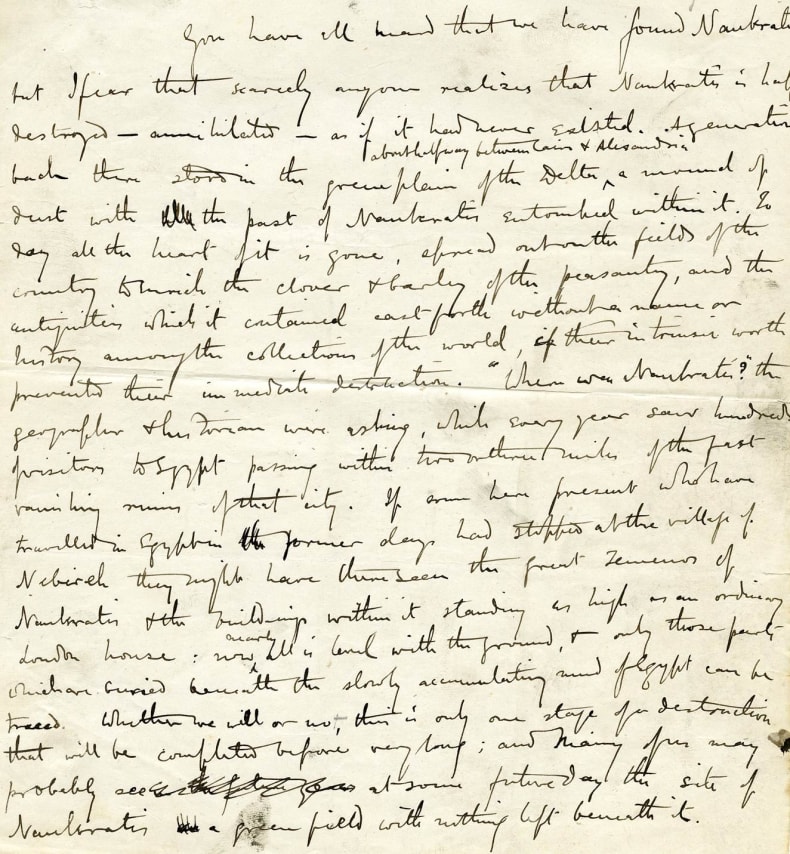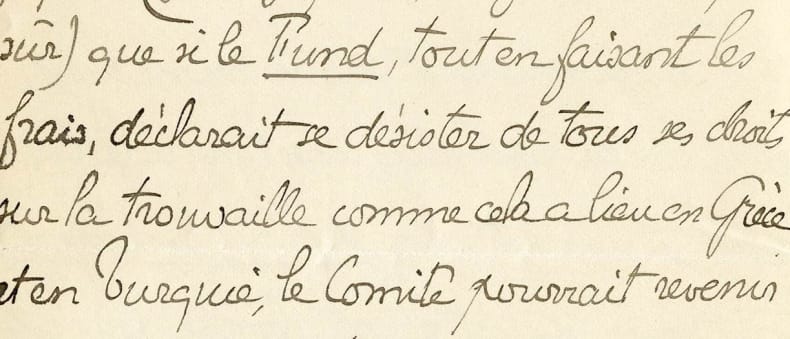Deciphering and discovering: Cataloguing the 'Early Correspondence'
In February 2014 we were very happy to welcome Dr Brigitte Balanda (below) to our team of dedicated volunteers in the Library and Archive. Since then, Brigitte has taken on the mammoth task of cataloguing, scanning and transcribing our unique collection of correspondence. In this brief report Brigitte discusses the beginnings of the project, and progress made so far.

The Society’s ‘Early Correspondence’ archive contains an estimated 6,000 letters, reports, newspaper clippings, fliers and other types of documents dating from the founding of the Society in 1882 to roughly the outbreak of the First World War. At present, these documents are stored in box files and folders within the EES Lucy Gura Archive at the London Offices at Doughty Mews. In February this year I started to catalogue, scan and transcribe the collection with the ultimate goal of making it available on-line so that researchers all over the world could have access to their contents, with the equally important benefit of preserving the letters in a digitized format.
At some point in the history of the Society, Margaret Drower organised the correspondence into general topics which she separated into marked box files. Within each of these boxes are several groupings of related letters, kept separately in envelopes or folders. Each of these envelopes bears a label summarising its contents and an alphanumerical marker. Within an envelope the documents are usually arranged by date and given an individual number. One of our initial considerations was whether to implement the new numbering system or to use the existing system initiated by Drower and expand and build upon it if and where necessary. Because the archive had already been used for research in the past, where the existing numbers were used for reference purposes (e.g. Brenda Moon 2006, More Usefully Employed), and also considering that the present system had become part of the collection’s history we opted for the latter option. The existing structure of the archive allows the identification of each document by its unique number (for example: EES II.b.175 is kept in box file EES II, envelope b, and bears the sequence number 175 within this envelope). For this reason the new identification system for the Lucy Gura Archive was tailored to follow a similar model as that initiated by Margaret Drower, so as to bring the collections under a single numbering system.
 EES.I.d.4 - notes for a lecture drafted by W. M. Flinders Petrie; transcribed for the project by Clare Lewis.
EES.I.d.4 - notes for a lecture drafted by W. M. Flinders Petrie; transcribed for the project by Clare Lewis.
The catalogue of the documents is currently being recorded in a spreadsheet containing, apart from the document number, information such as its author and the address it was sent from, date, recipient, type of document (e.g. letter, flier, postcard, minutes, report, telegram, etc.), the language it is written in, and a brief summary of its contents. Furthermore we record a physical description including measurements and any other observations (e.g. presence of punch holes, tears or creases, the occurrence of foxing) and an overall assessment of the condition. All metal pins and clips which were sometimes used to keep the pages of a document or a set of documents together are removed in the process for reasons of better conservation and replaced with less damaging plastic clips. Once a document has been logged it is scanned and, on the basis of this image(s), the document is transcribed. The advantage of working from a scan, rather than the original, is that the electronic version can be magnified on the computer screen, which in many cases makes reading the document much easier. Since June, Faye Kalloniatis has been editing the transcripts, giving them the final polish so that they are ready to go online. Deciphering the many different hands in which these letters, notes and reports were written can be a difficult and time consuming task. Petrie’s handwriting in particular is known to be difficult, especially when his correspondence was hastily scribbled in the field or en route (see EES.I.d.4 above). In contrast, the elegant handwriting of G. Maspero is one of the most beautiful examples to be found in the collection (see EES.I.h.7 opposite).
To date, the contents of two box files out of 37 have been recorded which equates to roughly 450 documents, of which 300 have already been transcribed. Among the treasures currently recorded is an envelope containing the letters sent back and forth between the Society for the Preservation of the Monuments of Ancient Egypt and the EES (then the Egypt Exploration Fund, EEF) regarding the threat posed to the island of Philae and the Temple of Isis by the construction of the first dam at Aswan in the 1890s (EES.I.b). Another example (EES.I.c.1) is a letter by Petrie, known to be quite outspoken, to the secretary of the EEF, Miss Emily Paterson, where he expresses in no uncertain terms his disapproval of Naville’s work at Deir el-Bahari and other sites:
Count D’H, (with M. Naville approving) told me, with superior wisdom, that in order to copy the graffiti at Medum I ought to have put a wet paper on the wall and beaten it so as to bring the ink away on the paper!!! This would be his way of treating a graffito – a priceless and irreplaceable record. Some part might come off, some would stick on, more would be washed away and the graffito would be no more. Now if graffiti are found – which is very likely – in Deir el Bahri, this cannot be a “thoroughly careful manner” of dealing with them. But this is what will happen, in spite of all the Committee’s assurances, if Messrs. N + H are sent there without a complete check on their actions.
In another example (EES.I.c.2) Petrie writes:
At Pithom sacks of incense were found, many pieces of fine sculptures (including the perfect face of Nectanebo) and other objects. None of these were brought by M. Naville. At Saft el Henneh the excavation had no relation to the former direction of the temple; a square pit was dug, destroying a large piece of the temple wall and not reaching the other side of the enclosure.
The contents of EES.II (actually consisting of three separate box files) concern relations with the American Branch of the EEF in the late 1890s/early 1900s. Although only a small selection from this series has so far been recorded documents allude to scandals and skulduggery. The exact course of events is not entirely clear yet, but further study should shed some light on this matter and I look forward to bringing further updates.
 EES.I.h.7 – part of a letter from Gaston Maspero, arguably some of the most beautiful handwriting in the collection.
EES.I.h.7 – part of a letter from Gaston Maspero, arguably some of the most beautiful handwriting in the collection.
The rather daunting task of cataloguing, scanning and transcribing the several thousand letters of the ‘Early Correspondence’ archive is estimated to take several years. But a substantial start has been made, and the initial results are already rewarding. Surely there are many more stories to be discovered which will give us fascinating insights into the minds of those involved in the formation of The Egypt Exploration Society.
